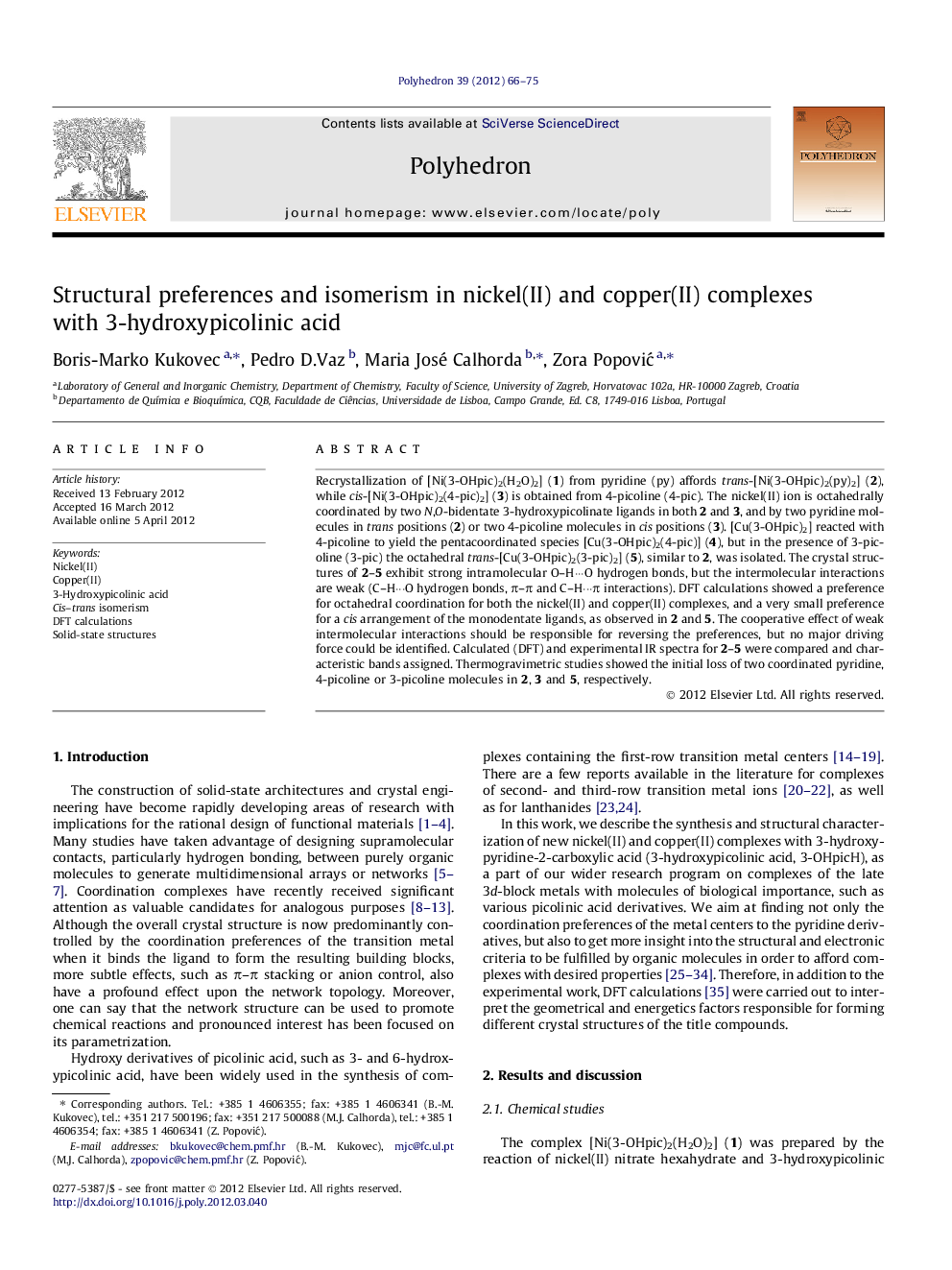| کد مقاله | کد نشریه | سال انتشار | مقاله انگلیسی | نسخه تمام متن |
|---|---|---|---|---|
| 1337582 | 979635 | 2012 | 10 صفحه PDF | دانلود رایگان |

Recrystallization of [Ni(3-OHpic)2(H2O)2] (1) from pyridine (py) affords trans-[Ni(3-OHpic)2(py)2] (2), while cis-[Ni(3-OHpic)2(4-pic)2] (3) is obtained from 4-picoline (4-pic). The nickel(II) ion is octahedrally coordinated by two N,O-bidentate 3-hydroxypicolinate ligands in both 2 and 3, and by two pyridine molecules in trans positions (2) or two 4-picoline molecules in cis positions (3). [Cu(3-OHpic)2] reacted with 4-picoline to yield the pentacoordinated species [Cu(3-OHpic)2(4-pic)] (4), but in the presence of 3-picoline (3-pic) the octahedral trans-[Cu(3-OHpic)2(3-pic)2] (5), similar to 2, was isolated. The crystal structures of 2–5 exhibit strong intramolecular O–H···O hydrogen bonds, but the intermolecular interactions are weak (C–H···O hydrogen bonds, π–π and C–H···π interactions). DFT calculations showed a preference for octahedral coordination for both the nickel(II) and copper(II) complexes, and a very small preference for a cis arrangement of the monodentate ligands, as observed in 2 and 5. The cooperative effect of weak intermolecular interactions should be responsible for reversing the preferences, but no major driving force could be identified. Calculated (DFT) and experimental IR spectra for 2–5 were compared and characteristic bands assigned. Thermogravimetric studies showed the initial loss of two coordinated pyridine, 4-picoline or 3-picoline molecules in 2, 3 and 5, respectively.
Trans-[Ni(3-OHpic)2(py)2] (2), cis-[Ni(3-OHpic)2(4-pic)2] (3), [Cu(3-OHpic)2(4-pic)] (4) and trans-[Cu(3-OHpic)2(3-pic)2] (5) were prepared and their crystal structures revealed by X-ray structural analysis. DFT calculations showed a preference for octahedral coordination for both nickel(II) and copper(II), and a very small preference for a cis arrangement of the monodentate ligands (in 2 and 5). The cooperative effect of weak intermolecular interactions is responsible for reversing the preferences.Figure optionsDownload as PowerPoint slideHighlights
► Trans-[Ni(3-OHpic)2(py)2] (2) and cis-[Ni(3-OHpic)2(4-pic)2] (3) have been prepared.
► [Cu(3-OHpic)2(4-pic)] (4) and trans-[Cu(3-OHpic)2(3-pic)2] (5) have been prepared.
► DFT calculations show a preference for octahedral coordination for both Ni(II) and Cu(II).
► There is a small preference for a cis arrangement of the monodentate ligands in 2 and 5.
► Calculated and experimental IR spectra for 2–5 have been compared and the characteristic bands assigned.
Journal: Polyhedron - Volume 39, Issue 1, 30 May 2012, Pages 66–75